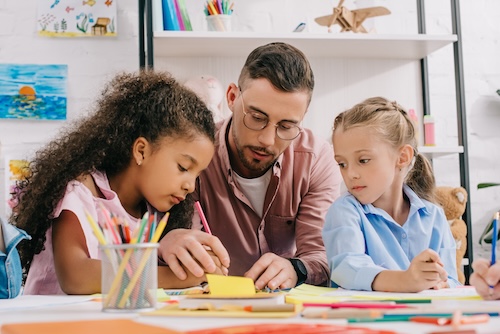Key points:
The first few weeks of school are more than a fresh start–they’re a powerful opportunity to lay the foundation for the relationships, habits, and learning that will define the rest of the year. During this time, students begin to decide whether they feel safe, valued, and connected in your classroom.
The stakes are high. According to the 2023 Youth Risk Behavior Survey, only 55 percent of students reported feeling connected to their school. That gap matters: Research consistently shows that a lack of belonging can harm grades, attendance, and classroom behavior. Conversely, a strong sense of belonging not only boosts academic self-efficacy but also supports physical and mental well-being.
In my work helping hundreds of districts and schools implement character development and future-ready skills programs, I’ve seen how intentionally fostering belonging from day one sets students–and educators–up for success. Patterns from schools that do this well have emerged, and these practices are worth replicating.
Here are three proven steps to build belonging right from the start.
1. Break the ice with purpose
Icebreakers might sound like old news, but the reality is that they work. Research shows these activities can significantly increase engagement and participation while fostering a greater sense of community. Students often describe improved classroom atmosphere, more willingness to speak up, and deeper peer connections after just a few sessions.
Some educators may worry that playful activities detract from a serious academic tone. In practice, they do the opposite. By helping students break down communication barriers, icebreakers pave the way for risk-taking, collaboration, and honest reflection–skills essential for deep learning.
Consider starting with activities that combine movement, play, and social awareness:
- Quick-think challenges: Build energy and self-awareness by rewarding quick and accurate responses.
- Collaborative missions: Engage students working toward a shared goal that demands communication and teamwork.
- Listen + act games: Help students develop adaptability through lighthearted games that involve following changing instructions in real time.
These activities are more than “fun warm-ups.” They set a tone that learning here will be active, cooperative, and inclusive.
2. Strengthen executive functioning for individual and collective success
When we talk about belonging, executive functioning skills–like planning, prioritizing, and self-monitoring–may not be the first thing we think of. Yet they’re deeply connected. Students who can organize their work, set goals, and regulate their emotions are better prepared to contribute positively to the class community.
Research backs this up. In a study of sixth graders, explicit instruction in executive functioning improved academics, social competence, and self-regulation. For educators, building these skills benefits both the individual and the group.
Here are a few ways to embed executive functioning into the early weeks:
- Task prioritization exercise: Help students identify and rank their tasks, building awareness of time and focus.
- Strengths + goals mapping: Guide students to recognize their strengths and set values-aligned goals, fostering agency.
- Mindful check-ins: Support holistic well-being by teaching students to name their emotions and practice stress-relief strategies.
One especially powerful approach is co-creating class norms. When students help define what a supportive, productive classroom looks like, they feel ownership over the space. They’re more invested in maintaining it, more likely to hold each other accountable, and better able to self-regulate toward the group’s shared vision.
3. Go beyond the first week to build deeper connections
Icebreakers are a great start, but true belonging comes from sustained, meaningful connection. It’s tempting to think that once names are learned and routines are set, the work is done–but the deeper benefits come from keeping this focus alive alongside academics.
The payoff is significant. School connectedness has been shown to reduce violence, protect against risky behaviors, and support long-term health and success. In other words, connection is not a “nice to have”–it’s a protective factor with lasting impact.
Here are some deeper connection strategies:
- Shared values agreement: Similar to creating class norms, identify the behaviors that promote safety, kindness, and understanding.
- Story swap: Have students share an experience or interest with a partner, then introduce each other to the class.
- Promote empathy in action: Teach students to articulate needs, seek clarification, and advocate for themselves and others.
These activities help students see one another as whole people, capable of compassion and understanding across differences. That human connection creates an environment where everyone can learn more effectively.
Take it campus-wide
These strategies aren’t limited to students. Adults on campus benefit from them, too. Professional development can start with icebreakers adapted for adults. Department or PLC meetings can incorporate goal-setting and reflective check-ins. Activities that build empathy and connection among staff help create a healthy, supportive adult culture that models the belonging we want students to experience.
When teachers feel connected and supported, they are more able to foster the same in their classrooms. That ripple effect–staff to students, students to peers–creates a stronger, more resilient school community.
Belonging isn’t a single event; it’s a practice. Start the year with purpose, keep connection alive alongside academic goals, and watch how it transforms your classroom and your campus culture. In doing so, you’ll give students more than a positive school year. You’ll give them tools and relationships they can carry for life.
This post is exclusively published on eduexpertisehub.com
Source link

